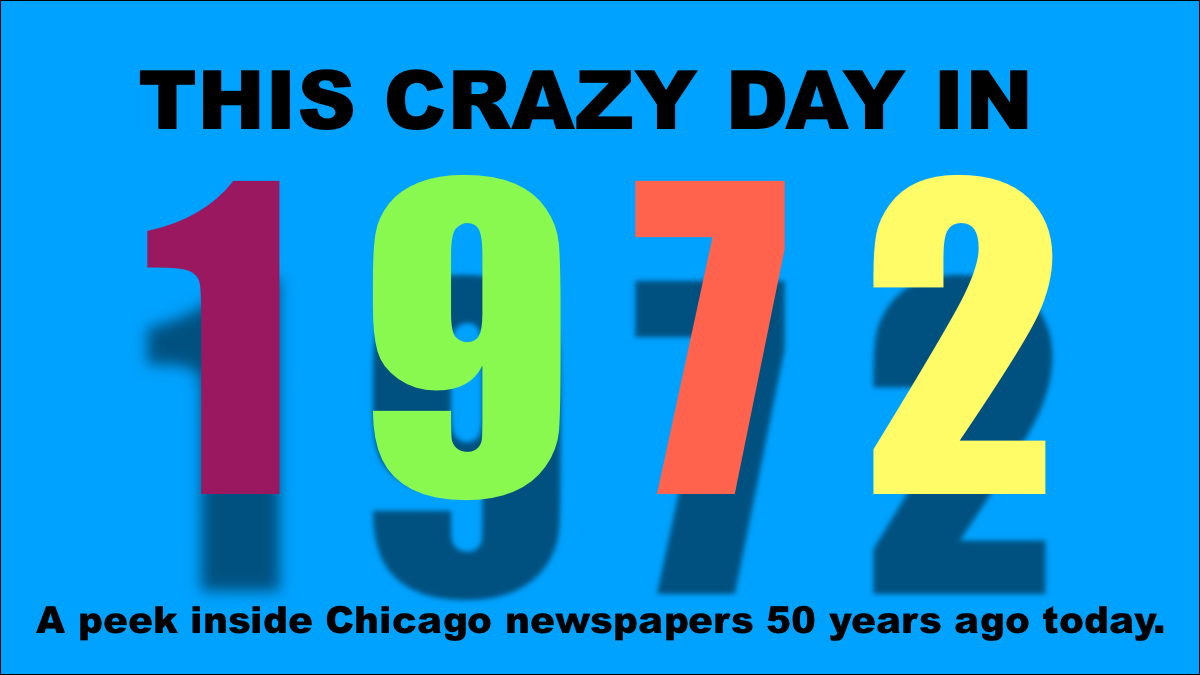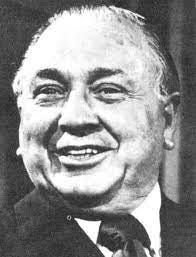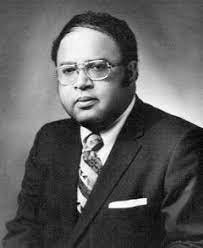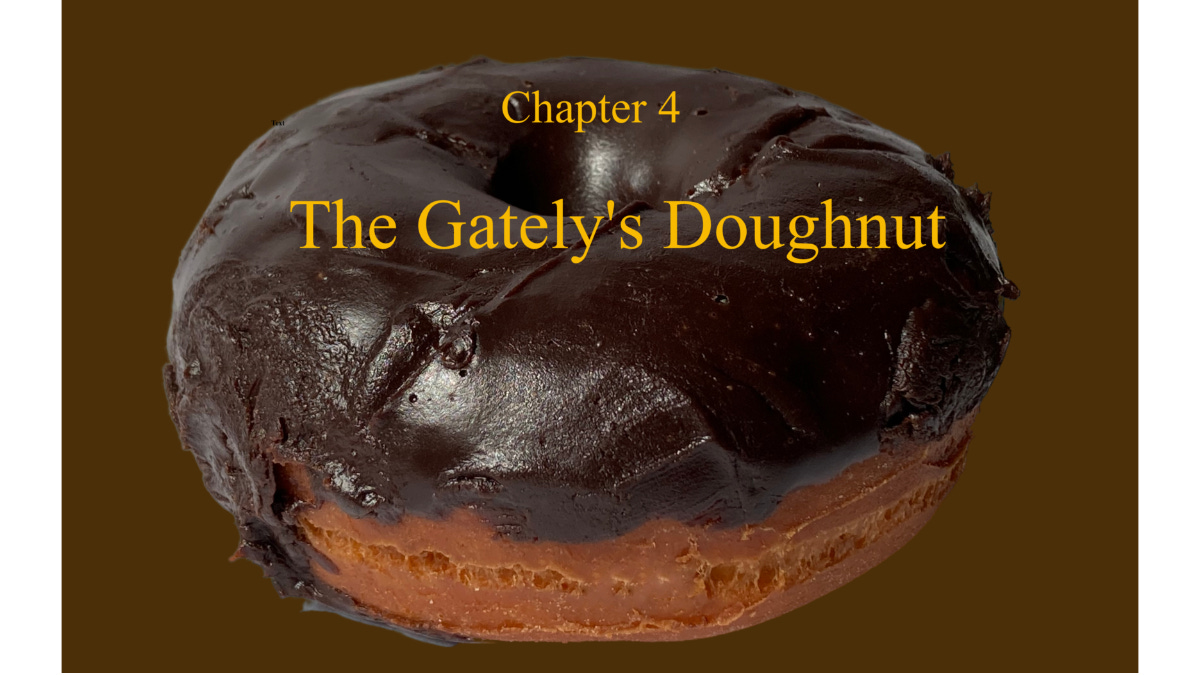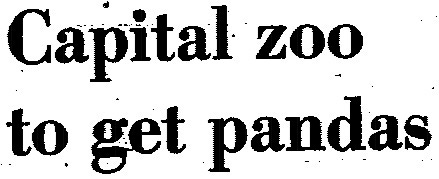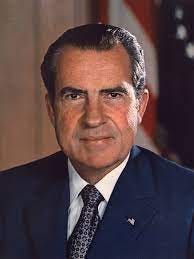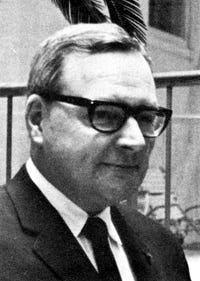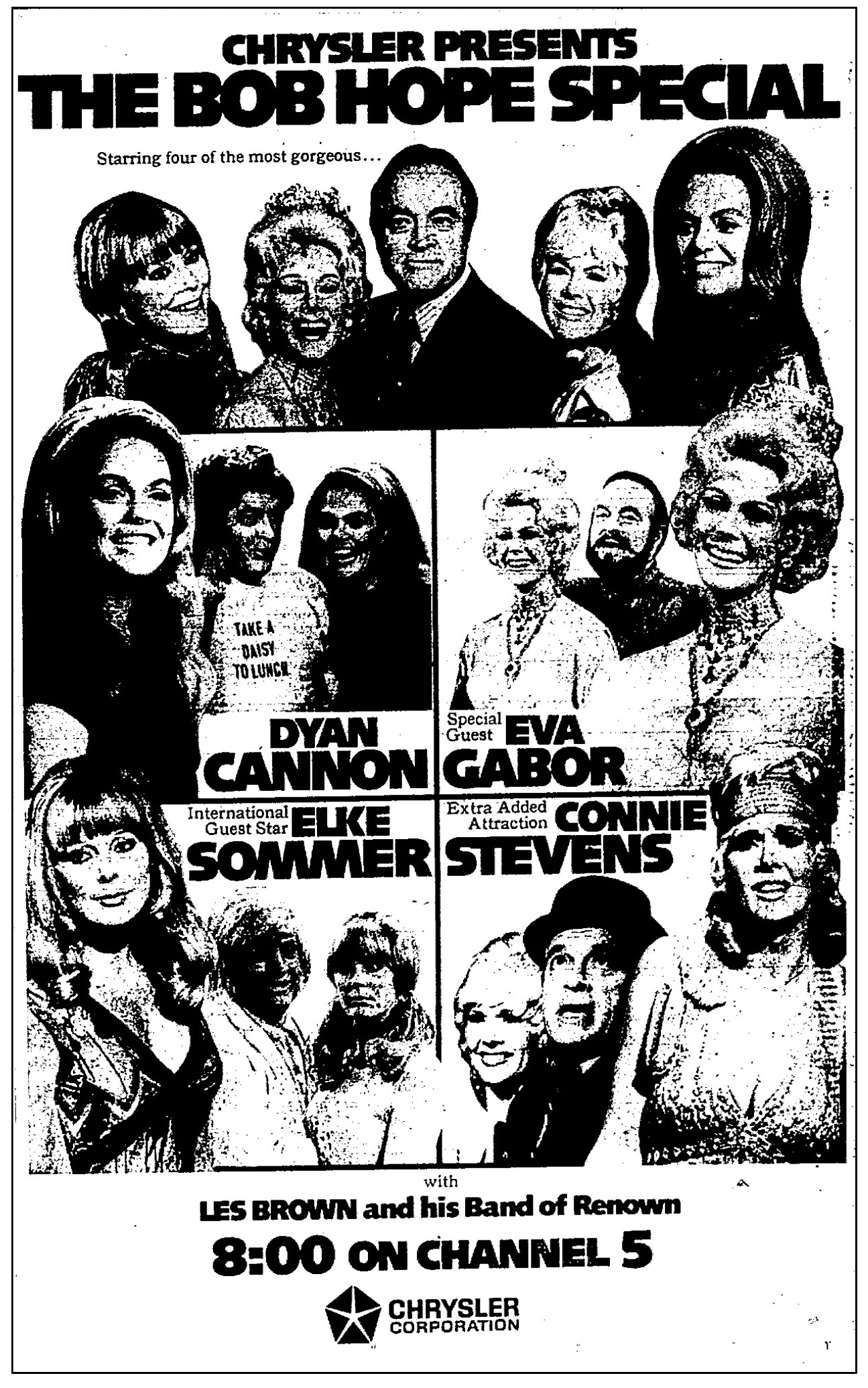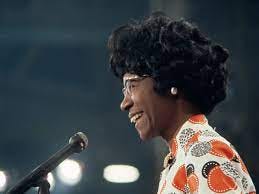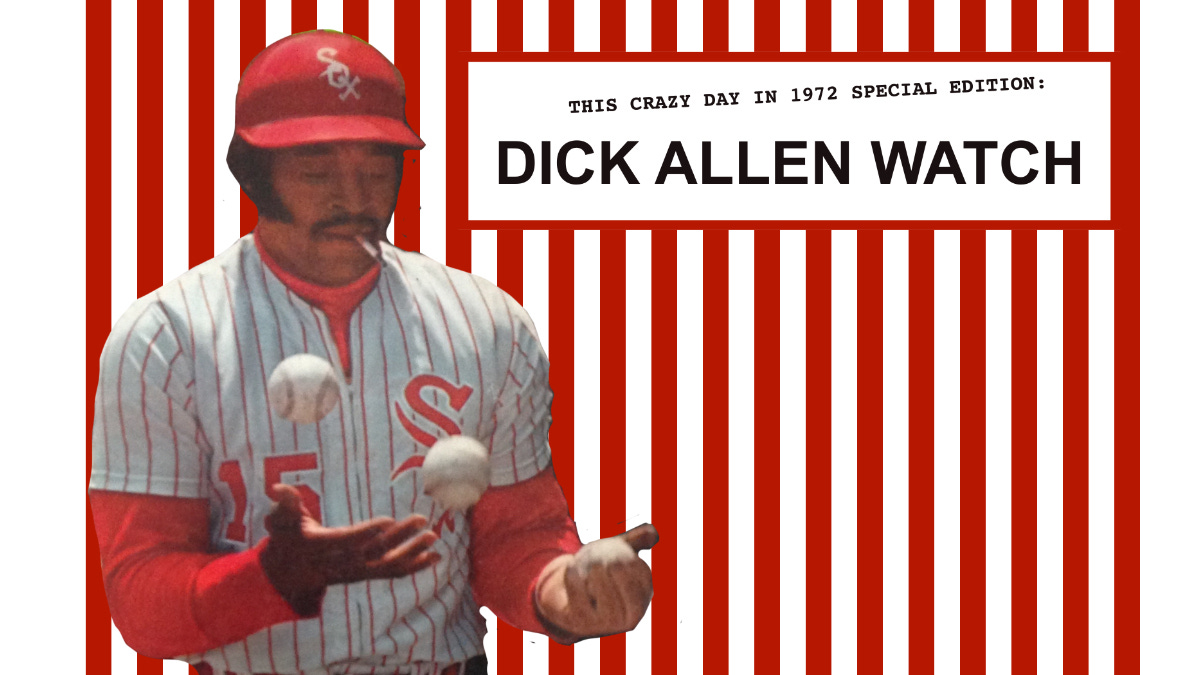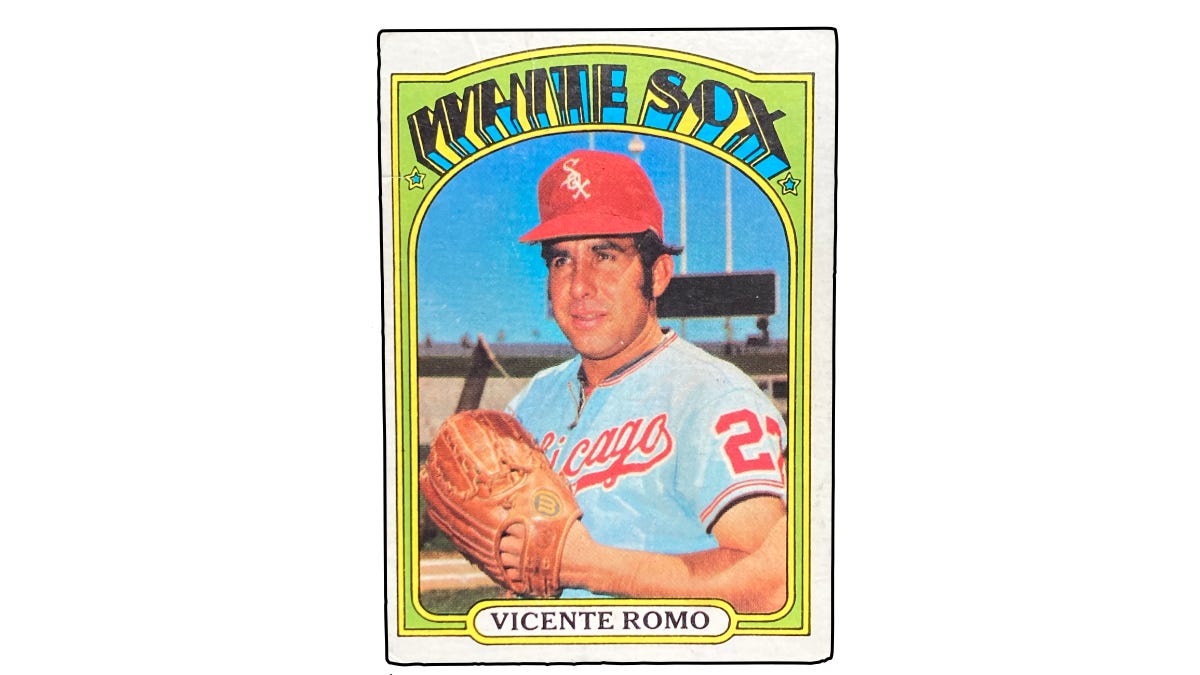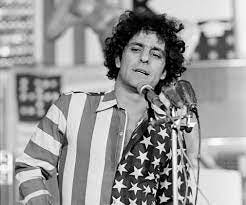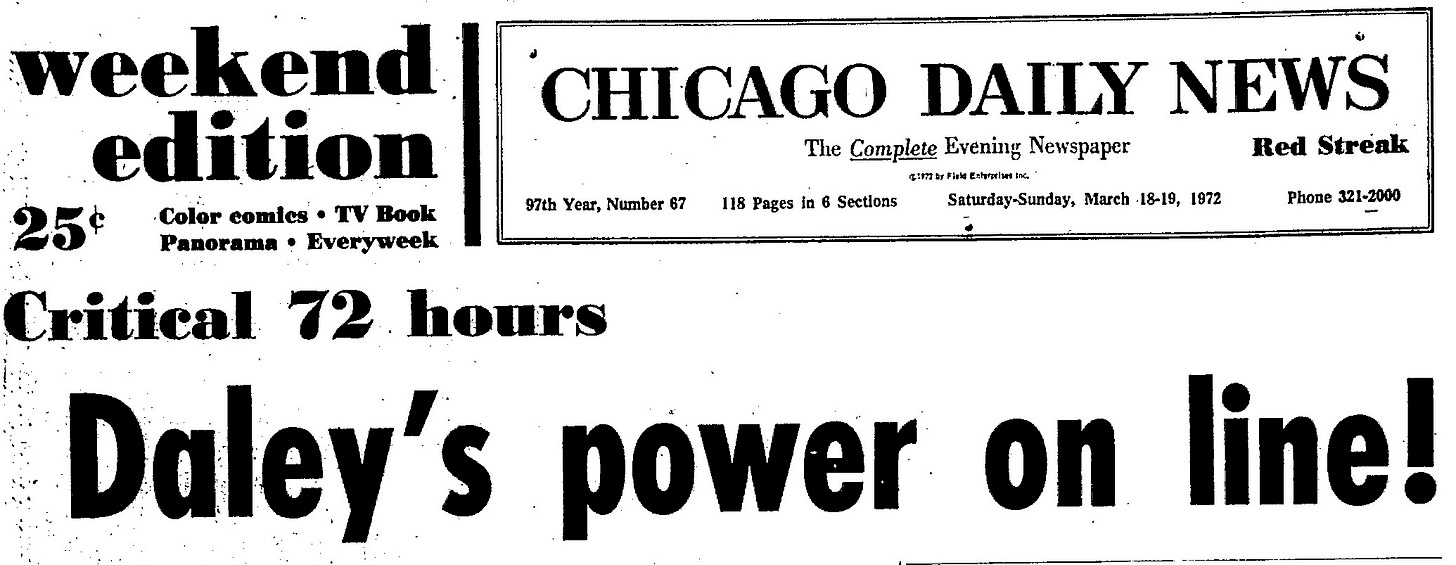THIS CRAZY DAY IN 1972: No Pandas For You
Weekly Compilation March 13-19, 1972
To access all contents, click HERE.
Why do we run this separate item peeking into newspapers from 1972? Because 1972 was part of the ancient times when everybody read a paper. Everybody, everybody, everybody. Even kids. So Steve Bertolucci, the 10-year-old hero of the novel serialized at this Substack, read the paper too—sometimes just to have something to do. These are some of the stories he read. If you’d like, keep up with the 1972 papers every day on Twitter, @RoselandChi1972.March 13, 1972
March 13, 1972
Chicago Daily News editorial: Time to ban the lake airport
Oh, you didn’t know Mayor Daley wanted to put an airport in the lake? Yep!
“We agree with Gov. Ogilvie that ‘the time has come for a clear, absolute, unequivocal legislative ban on an airport in Lake Michigan,” says the Tribune editorial board.
“Legislative machinery is already moving toward such a ban: Rep. Robert E. Mann’s Lake Michigan ‘bill of rights’ measure, passed by the House last year, woud require that such an airport have the approval of both the Legislature and the governor."
“Ogilvie would go further and impose a specific prohibition. The Legislature should provide it.
“What seemed like a promising idea when it was proposed a few years ago has long since been revealed as impractical and ecologically perilous.”
Yes—the Tribune here admits that the fantasy of building an airport out in Lake Michigan looked promising at first.
Environmental groups say it would be a disaster, and financial studies say it would cost up to four times more than a normal airport, the Trib notes. “Only Mayor Daley and his yes-men in and out of City Council cling to the lake airport notion--and even Daley hedges his advocacy, by adding, ‘….if it’s ecologically feasible.’”
Short answer: it’s not.
March 13, 1972
Chicago Daily News: Blacks at parley call for militant politics
By Lu Palmer and Betty Washington
The National Black Political Convention “balked at endorsing a presidential candidate” and “produced a militant black political agenda to implement the mandates of delegates”.
The convention drew “3,546 delegates from 43 states. The temporary agenda endorsed…calls for…a guaranteed annual income of $6,500 for a family of four and a minimum of 15 black senators and 66 black representatives in Congress.”
A resolution against school busing probably won’t “remain intact in the final document,” according to Palmer and Washington. The convention’s agenda should be finalized “by May 19, the birthday of Malcom X,” and then “become the instrument for negotiation with presidential candidates.”
“Blacks representing the gamut of black thought from separatism to integration debated, argued, and shouted. They kept presiding officer Imamu Amear Baraka, the poet, straining to hold the convention together.”
The convention “edged to the brink of collapse” several times. The Michigan delegation “stalked out” and Illinois almost joined them, “protesting that the black political agenda was being adopted without sufficient study.”
The anti-busing resolution was “drafted by nationalist groups” and opposed by the NAACP and Vice Mayor Henry Marsh of Richmond, Va, who said it “amounted to segregation.”
“The agenda calls for the establishment of black political representation in proportion to the black population, the establishment of residency requirements for all neighborhood police force units, and creation of a new urban-based Homestead Act to provide funds for urban housing programs.”
Of the presidential candidates, only Rep. Shirly Chisholm was invited, but she was campaigning in Florida. Percy Sutton, president of the Manhattan borough of New York, attempted to “swing the Gary convention behind” Chisholm, but the convention voted not to endorse anyone.
“The two major political parties will have to re-examine their attitudes toward black people,” said U.S. Rep. Diggs. “They will have to reckon with us now.”
Don’t miss the latest chapter! In which Steve’s Nonna, a Gately’s doughnut and a Roseland All-Stars Little League hat combine to teach young Steve the heartbreaking truth—that you can’t have everything.
March 13, 1972
Capital zoo to get pandas
By John Hahn
So much for daily panda stories and coupons to fill out and send to President Nixon begging him to send two pandas from Chinese premier Chou En-lai to Brookfield Zoo.
“President Nixon said Monday that two gift pandas…will go to the National Zoo in Washington. There were immediate promises that there would be renewed efforts to get two pandas for Chicago.”
Illinois Gov. Ogilvie hopes to visit China soon with others from the National Governors Conference: “My first order of business after getting there will be trying to get some pandas for Illinois.”
“Thousands of readers had clipped coupons printed by The Daily News and mailed them in an effort to convince the President to give the pandas to Brookfield Zoo. The coupons will continue to be forwarded to the President.”
Local Republican millionaire W. Clement Stone says he’ll personally ask Nixon to get to more pandas for us, and the Daily News contacted just about every other politicians in Illinois to say it’s a shame the pandas aren’t going to Brookfield.
Except for a Chicago Park District spokesperson, who still thinks the pandas should go to Lincoln Park Zoo.
March 13, 1972
Chicago Daily News: Bob Hope Special full-page ad
CBS airs yet another Bob Hope special. Even Bob doesn’t look that into it. Elke Sommer look positively sullen.
March 14, 1972
Chicago Daily News: Bob Hope censure over TV ‘slurs’ planned by Poles
No byline
Didja watch that Bob Hope special last night? Geez, I know.
Viewers were assaulted by an eight-minute parody of the gigantic William Friedkin hit movie starring Gene Hackman, “The French Connection,” titled “The Polish Connection.” Eight minutes. (And BTW, William Friedkin: Chicago boy!)
About 50 people called WMAQ, the local NBC affiliate, to complain.
FYR, you may wonder why Chicagoans didn't call NBC corporate offices in New York.
1) They could not email or post to social media;
2) You’d have to be a millionaire to call long distance to complain about a Bob Hope special. That’s how expensive long distance calls were in 1972.
“The film is a fast-moving thriller about international narcotics smugglers and a couple of tougher-than-nails New York City detetcives,” writes the Daily News. “But Hope’s Polish detective, a fellow named ‘Popeye Pollok’ was a stumblefoot who frisked his wife and shot the window washer.”
“The president of a powerful Polish American organization here said Tuesday she would call for censure of comedian Bob Hope for alleged slurs against Polish-Americans.”
“Our people are outraged,” said Mrs. Helen Zielinski, president of the Polish Women’s Alliance. “This is not the first time Mr. Hope has made fun of the Poles. Why should he do that with any ethnic group?”
“It wasn’t even funny,” Edward S. Dziewulski, Public Relations director for the Polish National Alliance, told the Daily News—and while people are prone to say that about things that make fun of themselves, in this case, Mr. Dziewulski is almost certainly objectively correct. “His writers were obviously scraping the bottom of the barrel looking for good material. The unfortunate thing is, I like Bob Hope.”
March 14, 1972
Chicago Daily Defender: Ethel L. Payne column
After Gary, what?

“GARY--Marcus Garvey, W.E.B. Du Bois as well as the latter-day saints of the civil rights struggle, Martin Luther King, Whitney Young and Malcom X, all must have looked on from the mists of the world beyond at the spectacle of Black Coming Together in Gary last week. That it happened at all was nothing short of a miracle.”
“It was inevitable that the hastiness with which the convention was put together would result in some massive mistakes,” writes Payne. The convention started late and “ground to halt on a minor procedural point,” before passing resolutions hastily “that needed extensive study and debate before commitment.”
The resolution against busing sent 20 years of the NAACP’s “painstaking, exhaustive legal work up in smoke” while the Congress of Racial Equality (CORE) pushed it and “called it the greatest triumph for black folks since the Civil War.”
The convention didn’t endorse starting a third party. “Not enough women were involved in the convention planning,” writes Payne, and not endorsing U.S. Representative Shirley Chisholm’s presidential candidacy left the convention “vulnerable” to charges of “male black chauvinism.”
March 14, 1972
Chicago Daily Defender: Charlie Cherokee Says
“Supporters of the Rev. Jesse Jackson were stunned at the Black Convention in Gary when they heard boos as their leader rose to address the group on Saturday. The boos came from members of the Washington, D.C. delegation who yelled, ‘No more speeches.’
The Jackson supporters countered the Washington D.C. delegation by chanting ‘We want Jesse.’ It was noted also that when Jesse called the roll of great leaders of this period, he included the name of the Rev. Ralph Abernathy.”
Note: Late last year, Jackson quit as head of the SCLC’s Operation Breadbasket in Chicago after SCLC suspended him with pay, while it investigated whether Jackson had set up nonprofit corporations to run Black Expo without informing SCLC. But everybody knew it was a personal conflict between young up-and- comer Jackson and movement elder SCLC head Rev. Ralph Abernathy. Jackson then created Operation PUSH, which he now heads.
Back to Charlie: “Simeon Booker, Washington bureau chief of Jet and Ebony, was heard offering to bet Alex Poinsett of the Chicago office of Johnson Publications that the delegates would endorse Rep. Shirley Chisholm” [for president].
As we already know, Booker lost that bet.
And yes, Younger Readers, the Defender ran a column called “Charlie Cherokee Says,” starting in the ‘40s. See the January 4 item here for more background.
March 14, 1972
Chicago Daily News: Dick Allen goes home
By John P. Carmichael
This headline is huge, above the Daily News masthead. Top of the front page.
“SARSOTA, Fla. - Dick Allen, in the flesh, appeared at the White Sox training base Tuesday, but he didn’t stay.”
Carmichael reports that Sox general manager Stu Holcomb met with Dick Allen for 20 minutes in Sarasota, where the Sox are in spring training, to get Allen to sign a contract. The Sox reportedly offered $120,000, but Allen wants more.
“So Allen told this writer he was going to Philadelphia to see his mother, and would not see Holcomb again,” writes Carmichael. “With that, he hopped in his rented Cadillac and drove off.”
And “Richie Allen” has officially become “Dick Allen” in the Daily News today. “Dick, formerly known as Richie” write Carmichael, is “supposed” to have spent spring training so far visiting his racehorses at Liberty Bell Park outside Philadelphia.
Don’t forget this week’s compilation of Mike Royko!
Mike may move to Lake Forest and get his neighbor's eyes poked out by the village board.
March 15, 1972
Chicago Daily News: Trial of De Stefano erupts in laughter
By Betty Washington
Chicago mobster Sam De Stefano is currently appearing in a great show in U.S. District Court Judge Richard B. Austin’s courtroom, starring as the defendant and the defense attorney. He is not a lawyer.
“Federal narcotics agent John Barseth testified that Eddie Crimaldi—the man De Stefano allegedly threatened—admitted he had been a juice-loan enforcer for De Stefano.
“De Stefano objected and asked loudly: ‘Juice? What kind of juice? Electric juice? Orange juice? Pineapple juice?’”
Crimaldi is too scared of De Stefano to appear at the trial himself. U.S. Attorney James R. Thompson, whose name might sound familiar since he will be Illinois Governor and get a building named after him, is prosecuting.
Thompson offered to have Crimaldi testify over the phone.
“‘I refuse,’ said De Stefano. ‘These are vicious people we’re dealing with (the government). I would have no way of knowing whether Crimaldi would be talking on the phone while someone held a machinegun in his ear.’”
Fellow defendant Frank Oliver asked Judge Austin if he could leave for minute to take a pill.
“OK,” said Austin. “And if you find a pill out there for me, bring it back, won’t you please.”
March 15, 1972
Chicago Daily News: Hanrahan dares Daley to debate
by Edmund J. Rooney
State’s Attorney Edward Hanrahan held a press conference that was more of a stand-up act. Hanrahan is indicted for allegedly conspiring to obstruct the investigation of his office’s pre-dawn 1969 police raid that killed Black Panthers Fred Hampton and Mark Clark—so on the last day to put a new candidate on the primary ballot, Mayor Daley dumped Hanrahan and replaced him with his pal Traffic Court Judge Raymond Berg.
Then every Machine flunky in City Hall and the County building spent six hours forging signatures on the voter petitions to get Berg on the ballot, due in the County clerk’s office that day by 5. Several investigations are still trying to get Berg off the ballot, and throughout the primary campaign, Berg has refused to debate his opponents, incumbent Hanrahan and independent Democrat Donald Moore.
Berg, apropos of nothing, told reporters last week that he could beat both Hanrahan and Moore in boxing, as he claimed he went to college on a boxing scholarship.
“At a laugh-filled press conference, Hanrahan refused to mention the name of his regular organization opponent, Raymond K. Berg…Instead, Hanrahan only identified Berg as ‘Joe Palooka.’”
…. “I still haven’t been able to get Joe Palooka out of his corner for a debate,’ Hanrahan said. ‘So, instead, I’m challenging the man who is propping him up, Richard J. Daley, his manager.’”
March 15, 1972
Sox to Allen: We won’t budge
By Dave Nightingale
Dave Nightingale doesn’t have any actual new facts since Dick Allen refused to sign a Sox contract during a meeting with Sox GM Stu Holcomb yesterday, so he embellishes some details from previous accounts.
Yesterday, we heard Dick Allen left the meeting and told the News’ John Carmichael he was going to Philadelphia to see his mother. Today, we get the direct quote: “’I’m going home to momma,’ said Allen, presumably meaning his mother in Wampum, Pa., and walked out of the hotel toward his car and points unknown.”
But Dick Allen didn’t catch a plane, so “Dick presumably still is sweating it out in 85-degree Florida weather Wednesday. Holcomb is openly frustrated by his dealings with Allen. ‘We aren’t that far apart,’ he complained. But Stu is adamant in his stand that (a) he’s not budging from his ($120,000) offer, and (b) the next move is Allen’s.”
Nightingale writes that Allen “asked Holcomb to trade him during their Tuesday confrontation”--which Carmichael yesterday described as a “conference” that Holcomb called “very pleasant”. Holcomb says “At this time, we would not consider it.”
The Sox “can’t begin to think of parting with anyone” else until they get Allen “on the playing field.” Nightingale says the “supposedly weak Sox bullpen has been nothing short of sensational” in spring training. Vicente Romo “blitzed six Cardinals in succession” at a game yesterday.
March 16, 1972
Chicago Daily News: Secret report blasts Panther raid probe
by Lu Palmer
“A blue-ribbon commission formed to investigate the 1969 Black Panther raid concluded that ‘neither the federal government nor the state sought to establish the truth,’ The Daily News learned Thursday.
“A report outlining this conclusion has been held under wraps for nine months, and staff members say the report ‘is in grave danger’ of never being made public.
“The report of the Commission of Inquiry concluded that Illinois Black Panther Chairman Fred Hampton ‘was shot from the doorway to his bedroom as he lay drugged and defenseless in bed.’”
Recall that incumbent State’s Attorney Ed Hanrahan is currently both running for re-election in the current Democratic primary, and under indictment for allegedly conspiring to obstruct the investigation into that raid, conducted by his office’s police in pre-dawn hours, which killed Hampton and Black Panther Mark Clark.
The Commission of Inquiry was chaired byU.S. Attorney General Ramsey Clark and NAACP executive director Roy. Wilkins, with 28 members including Rev. Jesse Jackson.
March 16, 1972
Chicago Daily News: Bare praise for male nudity
By Paul Galloway
“The nude centerfold of actor Burt Reynolds in the April issue of Cosmopolitan magazine drew comments from women that sounded strangely similar to those some men make about nude centerfolds of women,” writes Paul Galloway.
Galloway shows a pre-publication copy of the ground-breaking nude male centerfold to women in the Loop. “You have to leave something to the imagination,” says one.
“There is something left to the imagination,” writes Gallowy. “Reynolds, described as 36 years of age, part Cherokee and ‘witty, articulate and irreverent,’ is photographed as he sprawls across a bearskin rug.
“The actor’s right arm is propping up his head and his left arm is extended across his body in a calculated fashion. Reynolds has a slender, plastic-tipped cigar in his mouth and he is smiling.”
Burt Reynolds is currently in Chicago appearing in “The Rainmaker” at the Arlington Park Theater.
“’As an advocate of women’s lib,’ said Ruth Black, an executive secretary, ‘I think it’s fair.’ She had been asked if she felt men were being exploited by having their naked bodies shown in women’s magazines.”
March 16, 1972
Chicago Sun-Times: Black Caucus re-endorses busing despite Gary vote
By Eric Wentworth
“The 13-member Congressional Black Caucus underscored Wednesday its continuing support of busing as one means to desegregate schools despite the anti-busing vote at the National Black Political Convention in Gary, Ind. last Sunday.”
“Meanwhile, President Nixon summoned White House aides to his Camp David (Md.) retreat to help prepare the message on busing and educational policy that he will send Congress shortly.
“The caucus avoided any direct reference in Wednesday’s statement to the strong anti-busing vote in Gary….But the statement appeared clearly aimed at assuring fellow lawmakers and the public that the convention’s action wasn’t all that representative of black Americans’ views.
“The Gary convention overwhelmingly adopted a resolution condemning racial integration “as a bankrupt, suicidal method of desegregating schools, based on the false notion that black children are unable to learn unless they are in the same setting as white children.”
March 16, 1972
Chicago Daily News: Hubbard seat ruled vacant
By Jay McMullen
After many months and newspaper editorials, a special City Council subcommittee unanimously and finally acknowledged that 2nd ward Ald. Fred Hubbard is going, going, gone.
“Richard Curry, city corporation counsel, said Hubbard was ‘guilty of implied abandonment’ of his office by failure to attend any Council meeting since his disappearance last May 20.”
“Hubbard, 42, was the $25,000-a-year director of the Chicago Plan for Equal Opportunity, an organization to find jobs for blacks in the building trades. He disappeared when a shortage of $100,000 was uncovered in the federally financed Chicago Plan.”
….“Curry presented copies of arrest warrants again Hubbard as well as federal and state indictments charging him with embezzlement of about $100,000 from the Chicago Plan.”
Ald. Claude Holman (4th), a Mayor Daley stalwart, headed the Committee. He “repeatedly rose and asked if Hubbard was present or represented by a lawyer his queries drew no response.”
Hubbard was driving a rental car that turned up abandoned in the Vegas Flamingo Hotel parking lot, and that’s the last anybody knows about him. The Tribune began writing editorials in July calling for a special election to fill Hubbard’s seat. In February, independent Ald. Len Despres (5th) tried to get the Council to approve a special election, and he just got yelled at by Ald. Tom Keane, Mayor Daley’s right hand man.
On March 4, the Defender wrote, “The repeated refusal of the City Council to fill the Second Ward Aldermanic vacancy, in particular, leaves no doubt in the public mind that the politicians are putting the Democratic Party’s interest above the need and well being of the black people in the ward.”
March 18-19, 1972
Chicago Daily News: Mayor winged!
Hanrahan gives Daley the bird by parading two ‘peace doves’
By James H. Bowman
“State’s Attorney Edward V. Hanrahan has brought a touch of Abbie Hoffman to the city’s otherwise traditional observance of St. Patrick’s Day.”
“In a stunt worthy of the erstwhile Yippie chieftain, Hanrahan, marching in Friday’s St. Patrick’s Day parade, doffed his hat to Mayor Richard J. Daley and released two white doves that were held captive in a false bottom of the hat.”
“Those were doves of peace,’ said Hanrahan, who was dumped by Daley as the regular Democratic organization’s choice for state’s attorney.”
Hanrahan’s supporters carried “We Love Mayor Daley” signs, too.
“As Hanrahan marched past the reviewing stand where Daley was standing, he touched a high, wide-brimmed hat he was carrying to his head as if to salute the mayor. He then took a false bottom out of the hat and released the two birds.
“The mayor laughed and applauded and shook hands with Hanrahan when the state’s attorney walked over to the reviewing stand.”
Other Hanrahan campaign tactics that haven’t rated their own articles: “Hanrahan had his campaign buttons planted at a luncheon rally of Daley’s precinct captains. At a similar rally all the captains got a fortune cookie containing the message, ‘Hanrahan’s the man.’”
“A more serious aspect to the parade was a contingent of the Northern Ireland Aid Committee marching under the banner, ‘England, Get the Hell Out of Ireland!”
March 18-19, 1972
Chicago Daily News: Daley’s power on the line!
by Charles Nicodemus
Daily News Political Editor
“Mayor Richard Daley’s famed Democratic steamroller plunged into the most crucial 72 hours in its history Saturday, bent on crunching out a safe path for Ray Berg in the state’s attorney’s race in order to bat off a humiliating breakdown,” writes Daily News political editor Charles Nicodemus.
“With the entire underpinning of the Cook County Democratic Party threatened, captains streamed into the precincts for their final ‘blitz’ calls of the campaign, with many using the political equivalent of Knut Rockne’s impassioned ‘Win one for the Gipper.’”
Nicodemus quotes one precinct captain from the 40th Ward: “You’ve got to gimme a vote for Berg. If for no other reason, do it for me, personally, see? For me, understand? Everything’s on the line.”
March 18-19, 1972
Chicago Daily News: Lu Palmer column
Blacks take a long step at Gary
“A white editorialist has concluded that the black national political convention in Gary was ‘disappointing,’” writes Lu Palmer.
“A white political editor’s column is headlined ‘Blacks lost chance’ and again the conclusion is that delegates left the historic meeting cloaked in ‘bleak disappointment.’”
“These are the long-distance analyses and, from the viewpoint of a black writer who attended the convention from beginning to end, my evaluation of what happened and its impact is just the opposite.”
“What happened in Gary was the beginning of a long step toward political empowerment for blacks. That can only be disappointing for those people who don’t want to see that step taken.”
Palmer agrees that it was unfortunate that the convention’s adopted final agenda wasn’t presented to the full convention after many negotiations and additions, but says it’s a “working paper” that will be refined by a National Black Political Council “composed of the state delegation chairmen and representatives of national black organizations.”
“The agenda--which is a compilation of black demands--has been criticized as being too militant, too radical to ever be adopted by a presidential candidate in exchange for black voters. This is a naïve evaluation of the document…when you are after 100, you demand 125.
…. “By no means was Gary a disappointment. It was an invaluable learning experience. By no means was Gary ‘a lost chance.’ The Gary convention was a last chance for the established political parties so far as blacks are concerned.
“And that could very well mean a last chance for America.”
March 18-19, 1972
Chicago Daily News: Can we exorcise the ghosts of Sears Tower?
by Norman Mark
Daily News TV critic Norman Mark pens an in-depth look for the paper’s weekend Panorama section at the danger of the slowly growing Sears Tower, which might destroy Chicago’s TV reception.
Every single Chicagoan relies on a TV antenna on top of their own individual roof to catch TV signals out of the air, so this topic is heating up the higher Sears Tower grows.
The problem is “ghosts”—when the TV picture is basically duplicated so you see “ghosts” of the main picture hovering around in the background.
“The taller the building, the more television interference it is likely to cause,” writes Mark. “And if a building is almost parallel in height to TV antennas sending out telecasts, the interference it creates will travel almost as far as the TV signal goes.”
“Sears, Roebuck & Co. is currently building a tower that will rise 1,000 feet above ground in the Loop at Wacker, Jackson, Adams and Franklin. It will sit about 8,000 feet southwest of the John Hancock Center, which is 1,456 feet tall with its TV antennas at 875 N. Michigan Av.
“Those antennas currently carry the signals for Channels 2, 5, 9, 32 and 44, with Channels 11 and 20 now exploring ways to move to the Hancock Center. Channels 7 and 26 are located elsewhere, but the Hancock Center antennas also house a growing number of FM stations.”
Right now, broadcasters predict 534,000 Chicagoland TVs will “have Sears ghosts in their future,” while a citizen’s group says it will be 1 million. The Lake County state’s attorney filed a lawsuit to stop Sears Tower construction, since it will “create a permanent public nuisance.”
Sears claims it has found new building techniques to fix the Tower’s interference so only 10,500 TVs will be affected, and even then, Channels 2, 5, 9 and 11 will have “maximum ghost level that is generally considered acceptable” while Channel 7 might have “slightly” more.
Sears’ goal of “generally acceptable ghosting” means “about 8 percent of the primary signal,” Mark explains. “With 8 percent ghosting conditions, a TV picture of a person’s head is accompanied by a second head about four inches to the right of the first. It tends to be an outline of the face and does not seem disturbing if the person on the screen doesn’t move around too much.”
Also, you could expect three to four vertical lines on the left side of the TV screen.
Nobody really knows what the ultimate effect will be.
“It is difficult to know just who will or will not be affected by ghosts from the World’s Tallest Building. Sears refuses for now to show reporters or engineers its maps or studies, and the maps issued with its press releases show Chicago and Libertyville, with no intersections, villages or cities in between.”
Sears has hired a bunch of people to try to solve the problem, but, writes Mark, “Sears has refused to accept the broadcasters’ most urgently argued solution—to lower the building 250 feet so that the antenna signal will hit the building from above and the reflected signal will eventually be driven into the ground.”
Don’t forget Chapter Three Notes: Chicago Newspapers Circa 1972!
Did you dig spending time in 1972? If you came to THIS CRAZY DAY IN 1972 from social media, you may not know it’s part of the novel being serialized here, one chapter per month: “Roseland, Chicago: 1972” —FREE. It’s the story of Steve Bertolucci, 10-year-old Roselander in 1972, and what becomes of him. Check it out here.
LikeCommentShare



